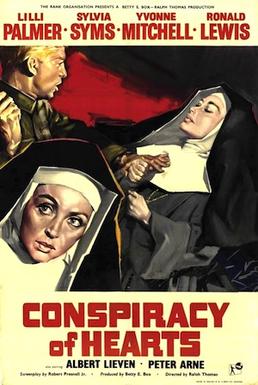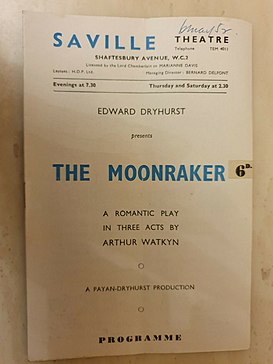
Ice Cold in Alex is a 1958 British war film set during the Western Desert campaign of World War II based on the novel of the same name by Christopher Landon. Directed by J. Lee Thompson and starring John Mills, the film was a prizewinner at the 8th Berlin International Film Festival. Under the title Desert Attack, a shortened, 79-minute version of the film was released in the United States in 1961. Film critic Craig Butler later referred to the shortened versions as nonsensical.

Sylvia May Laura Syms was an English stage and screen actress. Her best-known film roles include My Teenage Daughter (1956), Woman in a Dressing Gown (1957), for which she was nominated for a BAFTA Award, Ice Cold in Alex (1958), No Trees in the Street (1959), Victim (1961), and The Tamarind Seed (1974).

Ferry to Hong Kong is a 1959 British melodrama/adventure film directed by Lewis Gilbert and starring Curt Jürgens, Sylvia Syms, Orson Welles and Jeremy Spenser.

Associated British Picture Corporation (ABPC), originally British International Pictures (BIP), was a British film production, distribution and exhibition company active from 1927 until 1970 when it was absorbed into EMI. ABPC also owned approximately 500 cinemas in Britain by 1943, and in the 1950s and 60s owned a station on the ITV television network. The studio was partly owned by Warner Bros. from about 1940 until 1969; the American company also owned a stake in ABPC's distribution arm, Warner-Pathé, from 1958. It formed one half of a vertically integrated film industry duopoly in Britain with the Rank Organisation.

The Quare Fellow is Brendan Behan's first play, first produced in 1954. The title is taken from a Hiberno-English pronunciation of queer.

Woman in a Dressing Gown is a 1957 British drama film directed by J. Lee Thompson and starring Yvonne Mitchell, Anthony Quayle, Sylvia Syms, and Carole Lesley.

I Was Monty's Double is a 1958 film produced by the Associated British Picture Corporation and directed by John Guillermin. The screenplay was adapted by Bryan Forbes from the autobiography of M. E. Clifton James, an actor who pretended to be General Bernard Montgomery as a decoy during World War II.

Our Man in Marrakesh is a 1966 British comedy spy film shot in Morocco produced and co-written by Harry Alan Towers, directed by Don Sharp and starring Tony Randall, Herbert Lom and Senta Berger.

Conspiracy of Hearts is a 1960 British Second World War film, directed by Ralph Thomas, about nuns in Italy smuggling Jewish children out of an internment camp near their convent to save them from The Holocaust. It stars Lilli Palmer, Sylvia Syms, Yvonne Mitchell and Ronald Lewis, and was nominated for a Golden Globe for Best Film Promoting International Understanding at the 18th Golden Globe Awards in 1961.

The Birthday Present is a 1957 British drama film directed by Pat Jackson and starring Tony Britton and Sylvia Syms. The screenplay was by Jack Whittingham.

Flame in the Streets is a 1961 film directed by Roy Ward Baker and based on the 1958 play Hot Summer Night by Ted Willis. It opened at the Odeon Leicester Square in London's West End on 22 June 1961.

We Joined the Navy is a 1962 British comedy film directed by Wendy Toye and starring Kenneth More, Lloyd Nolan, Joan O'Brien, Derek Fowlds, Graham Crowden, Esma Cannon and John Le Mesurier. Produced by Daniel M. Angel, it was based on the 1959 novel of the same name by John Winton, a former Royal Navy lieutenant commander.

Thatcher: The Final Days is a 1991 British television film about the events surrounding the final few days of Margaret Thatcher's time as Prime Minister. The film was written by Richard Maher, directed by Tim Sullivan and starred Sylvia Syms in the role of Thatcher. The film was produced for ITV by Granada Television and first shown on ITV on Wednesday 11 September 1991 at 9:00pm.

For Better, for Worse is a 1954 British comedy film in Eastmancolor directed by J. Lee Thompson and starring Dirk Bogarde, Susan Stephen and Cecil Parker. It was based on Arthur Watkyn's play of the same title.

Masquerade is a 1965 British comedy thriller film directed by Basil Dearden based on the 1954 novel Castle Minerva by Victor Canning. It stars Cliff Robertson and Jack Hawkins and was filmed in Spain.

No Time for Tears is a 1957 British drama film directed by Cyril Frankel in CinemaScope and Eastman Color and starring Anna Neagle, George Baker, Sylvia Syms and Anthony Quayle. The staff at a children's hospital struggle with their workload.

My Teenage Daughter is a 1956 British drama film directed by Herbert Wilcox and starring Anna Neagle, Sylvia Syms and Norman Wooland. The screenplay concerns a mother who tries to deal with her teenage daughter's descent into delinquency. It was intended as a British response to Rebel Without a Cause (1955). It was the last commercially successful film made by Wilcox.
Robert Clark (1905–1984) was a Scottish film executive best known for being head of production at Associated British Picture Corporation in the late 1940s and 1950s. It was a successful time for the company, films including The Dam Busters (1955).
Arthur Thomas Levi Watkins was a British public official who served as Secretary of the British Board of Film Censors from 1948 to 1956, then as vice-president of the British Film Producers' Association.

For the James Bond novel of similar title, see Moonraker.


















